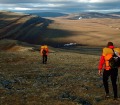Have you ever trained barefoot? Lately, I’ve seen more people jogging completely barefoot in the park. I’d like to explore the potential advantages and disadvantages.
Advantages of Barefoot Training
- Natural Movement: Barefoot training allows feet to move more freely, strengthening foot and lower leg muscles. This can improve balance and stability, reducing the risk of falls during various physical activities.
- Efficient Stride: Running or walking without shoes can lead to a more efficient and natural stride pattern, promoting midfoot or forefoot striking. This can reduce joint stress and lower the risk of certain overuse injuries.
- Heightened Awareness: Training without shoes enhances awareness of the ground, leading to adjustments in form and technique, potentially improving overall performance and reducing injury risks.
Potential Drawbacks of Barefoot Training
- Existing Foot Conditions: For those with conditions like plantar fasciitis or Achilles tendinitis, barefoot running may worsen these issues due to lack of support and cushioning.
- Injury Risk: The absence of protective footwear in high-impact activities like jumping or sprinting can increase the risk of bruises or stress fractures.
Transitioning to Barefoot Training
- Gradual Transition: I’ll discuss how to transition effectively, which surfaces to prefer, and how to incorporate barefoot training into your routine.
- Listen to Your Body: Always pay attention to signs of pain or discomfort during barefoot training. If you experience persistent or severe foot pain, consult a doctor or podiatrist.
Benefits of Barefoot Training
- Improved Balance and Proprioception: Barefoot running activates sensory receptors in the feet, enhancing balance and proprioception. This can improve stability and coordination, benefiting various physical activities and sports.
- Increased Foot Muscle Strength: Traditional footwear can restrict natural foot movement, leading to weakness. Barefoot training allows free movement, strengthening intrinsic muscles essential for proper foot mechanics and arch support.
- Better Biomechanics: Barefoot running promotes a natural gait, reducing the risk of common overuse injuries like plantar fasciitis, shin splints, and stress fractures, optimizing overall biomechanics.
- Enhanced Sensory Feedback: Training without shoes provides direct sensory feedback from the ground, improving body awareness and environmental connection, which can enhance movement patterns and posture.
- Cost-Effective and Convenient: Minimal equipment is needed, making barefoot training a cost-effective and convenient way to enhance your fitness routine at home, in the gym, or outdoors.
- Improved Circulation and Foot Health: Barefoot running enhances circulation in the feet, aiding recovery after intense exercise. The increased contact with various surfaces stimulates nerves, promoting overall foot health and reducing the risk of conditions like numbness or neuropathy.
- Mind-Body Connection: Barefoot training fosters a deeper mind-body connection, engaging with the ground beneath. Focusing on how your feet interact with different surfaces cultivates mindfulness, presence, and a deeper sense of grounding during workouts.
- Fun and Enjoyable Experience: Many find barefoot training fun and enjoyable, adding a sense of freedom and playfulness to workouts. Connecting with the earth can bring joy and vitality, making each session more interesting and fulfilling.
Minimal Shoes as a Compromise
If you prefer not to train barefoot, minimal shoes offer the best compromise. They provide freedom and flexibility with no heel drop and minimal cushioning, yet still protect your feet, which is especially beneficial for training in nature.













